牛津英语上海版四年级下册m2u1备课教案
- 格式:doc
- 大小:37.00 KB
- 文档页数:3
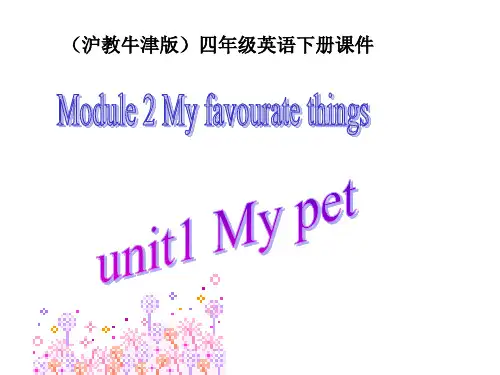
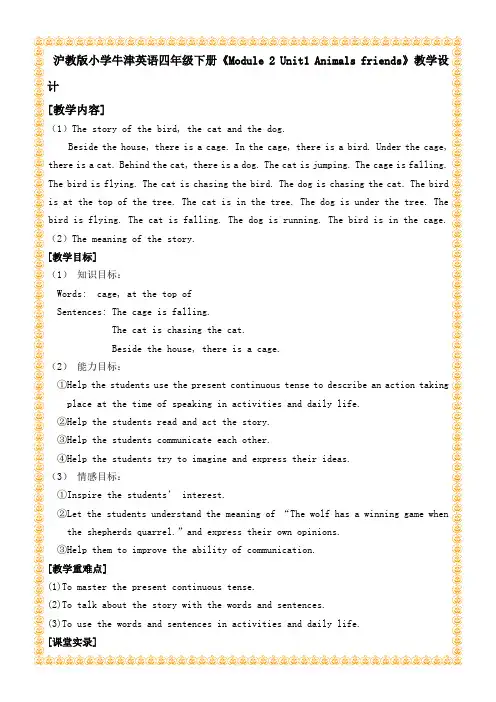
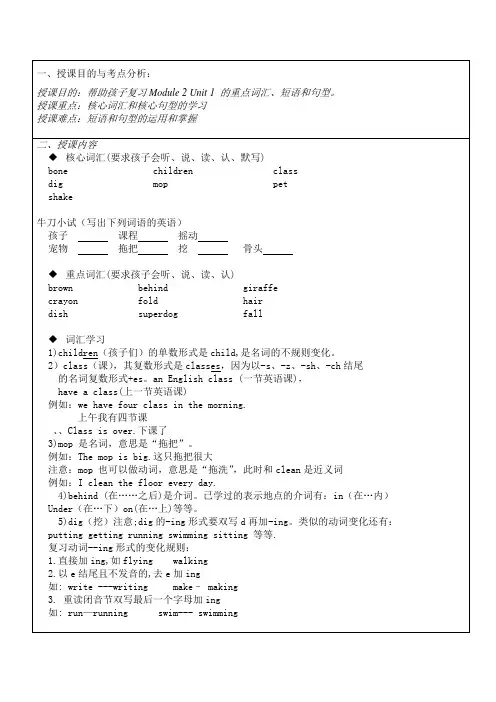
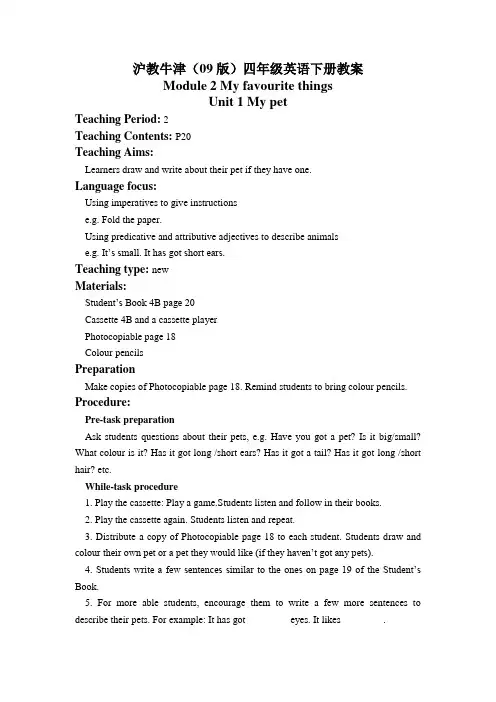
沪教牛津(09版)四年级英语下册教案Module 2 My favourite thingsUnit 1 My petTeaching Period: 2Teaching Contents: P20Teaching Aims:Learners draw and write about their pet if they have one.Language focus:Using imperatives to give instructionse.g. Fold the paper.Using predicative and attributive adjectives to describe animalse.g. It’s small. It has got short ears.Teaching type: newMaterials:Student’s Book 4B page 20Cassette 4B and a cassette playerPhotocopiable page 18Colour pencilsPreparationMake copies of Photocopiable page 18. Remind students to bring colour pencils. Procedure:Pre-task preparationAsk students questions about their pets, e.g. Have you got a pet? Is it big/small? What colour is it? Has it got long /short ears? Has it got a tail? Has it got long /short hair? etc.While-task procedure1. Play the cassette: Play a game.Students listen and follow in their books.2. Play the cassette again. Students listen and repeat.3. Distribute a copy of Photocopiable page 18 to each student. Students draw and colour their own pet or a pet they would like (if they haven’t got any pets).4. Students write a few sentences similar to the ones on page 19 of the Student’s Book.5. For more able students, encourage them to write a few more sentences to describe their pets. For example: It has got ________ eyes. It likes ________.6. Remind students to fold the paper in the same way as shown in the Student’s Book.7. Divide students into pairs or groups. Students take turns to read their classmates’ work and make guess of what pets they have got.8. Members of a group put their work together and form a pet book. Encourage students to design and make a cover for their book.学生小组活动进行介绍或者写写自己的宠物。
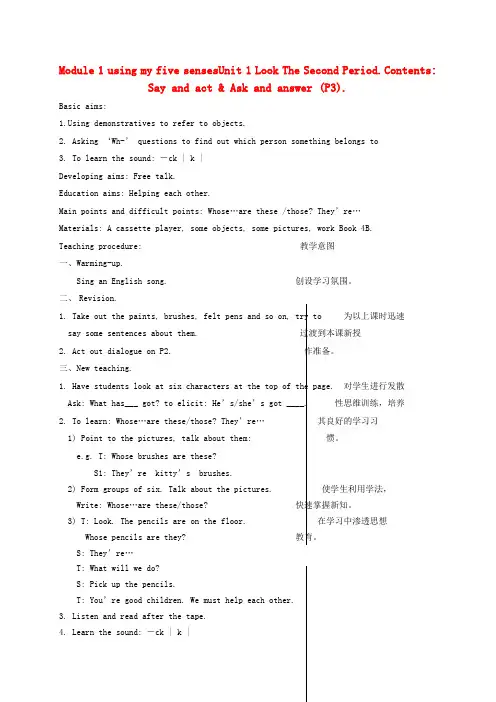
Module 1 using my five sensesUnit 1 Look The Second Period.Contents: Say and act & Ask and answer (P3).Basic aims:ing demonstratives to refer to objects.2. Asking ‘Wh-’ questions to find out which person something belongs to3. To learn the sound: -ck | k |Developing aims: Free talk.Education aims: Helping each other.Main points and difficult points: Whose…are these /those? They’re…Materials: A cassette player, some objects, some pictures, work Book 4B.Teaching procedure: 教学意图一、Warming-up.Sing an English song. 创设学习氛围。
二、Revision.1. Take out the paints, brushes, felt pens and so on, try to 为以上课时迅速say some sentences about them. 过渡到本课新授2. Act out dialogue on P2. 作准备。
三、New teaching.1. Have students look at six characters at the top of the page. 对学生进行发散Ask: What has___ got? to elicit: He’s/she’s got ____.性思维训练,培养2. To learn: Whose…are these/those? They’re…其良好的学习习1) Point to the pictures, talk about them: 惯。
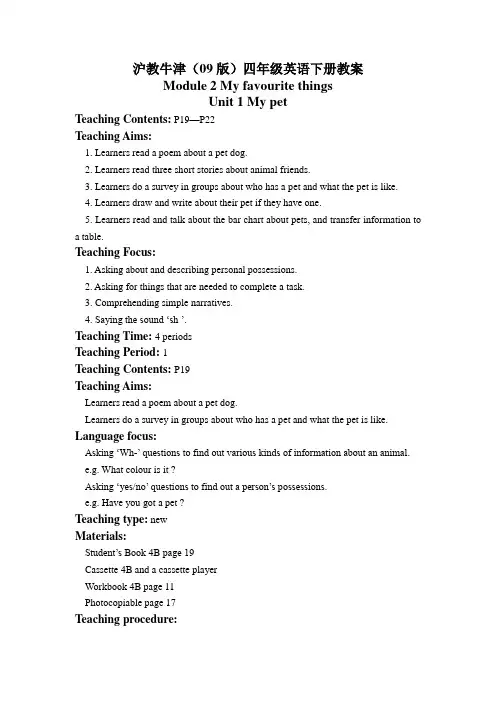
沪教牛津(09版)四年级英语下册教案Module 2 My favourite thingsUnit 1 My petTeaching Contents: P19—P22Teaching Aims:1. Learners read a poem about a pet dog.2. Learners read three short stories about animal friends.3. Learners do a survey in groups about who has a pet and what the pet is like.4. Learners draw and write about their pet if they have one.5. Learners read and talk about the bar chart about pets, and transfer information toa table.Teaching Focus:1. Asking about and describing personal possessions.2. Asking for things that are needed to complete a task.3. Comprehending simple narratives.4. Saying the sound ‘sh ’.Teaching Time: 4 periodsTeaching Period: 1Teaching Contents: P19Teaching Aims:Learners read a poem about a pet dog.Learners do a survey in groups about who has a pet and what the pet is like. Language focus:Asking ‘Wh-’ questions to find out various kinds of information about an animal.e.g. What colour is it ?Asking ‘yes/no’ questions to find out a person’s possessions.e.g. Have you got a pet ?Teaching type: newMaterials:Student’s Book 4B page 19Cassette 4B and a cassette playerWorkbook 4B page 11Photocopiable page 17Teaching procedure:Pre-task preparationAsking students to look at the picture in Read a poem and list the things in it. Introduce: mop by drawing a mop on the board.Invite students to guess where the dog is.While-task procedure1. Play the cassette: Read a poem. Students listen and follow in their books.2. Play the cassette again. Students listen and repeat.3. Divide students into three groups. Group A reads the first three lines, Group B reads the fourth to the sixth lines and Group C reads the last three lines.4. Invite individual students to read the poem.5. Encourage students to list the animals they know on the board.6. Invite individual students to circle the animals that people keep in their houses as pets. Introduce: a pet.7. Asking students if they have got a pet. Ask: Have you got a pet? To elicit: Yes, I’ve got a_______./No, I haven’t got a ny pets.8. Play the cassette: Do a survey. Students listen and follow in their books.9. Play the cassette again. Students listen and repeat.10. Distribute a copy of Photocopiable page 17 to each student.Have students do a simple survey on the pets of their classmates using the dialogue in Do a survey.11. Allow five minutes for the students to finish their survey.12. Divide students into groups.Students take turns to report to their group members on their survey.让学生说自己的宠物和猜别人的宠物是什么?增加behind的反义词in front of 以及与beside 的拼写区别Post-task activityWorkbook page 111. Students work in pairs to complete the dialogue orally.2. Invite pairs of students to read the dialogue to the class.3. Have students fill in the blanks to complete the dialogue.ConsolidationAt this stage Grammar Practice Book 4B, page 17 and 18 could be used to practice and consolidate the oral and written language in this section further.教学效果反馈:1. 教学目标达到。
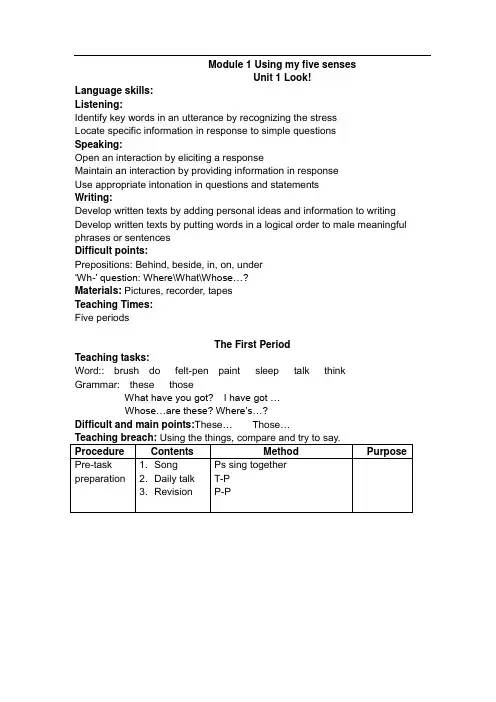
Module 1 Using my five sensesUnit 1 Look!Language skills:Listening:Identify key words in an utterance by recognizing the stressLocate specific information in response to simple questionsSpeaking:Open an interaction by eliciting a responseMaintain an interaction by providing information in responseUse appropriate intonation in questions and statementsWriting:Develop written texts by adding personal ideas and information to writing Develop written texts by putting words in a logical order to male meaningful phrases or sentencesDifficult points:Prepositions: Behind, beside, in, on, under‘Wh-’ question: Where\What\Whose…?Materials: Pictures, recorder, tapesTeaching Times:Five periodsThe First PeriodTeaching tasks:Word:: brush do felt-pen paint sleep talk think Grammar: these thoseWhat have you got? I have got …Whose…are these? Where’s…?Difficult and main points:These… T hose…The Second Period Teaching tasksGrammar: Whose…are these/those?Sounds: -ckTeaching contents: 1. Whose paints are these /those?They’re Betty’s paints.2. -ckDifficult points: whose pens are these?Teaching breach: Using the things to practice the sentence:Whose --- are these/those?The Third PeriodTeaching contentsUsing the present continuous tense to describe an action taking place at the time of speakingTeaching contentsWhat are the children doing? I’m doing…What’s he /she doing?He’s/She’s…Are you…? Yes/No.I’mDifficult and main point: Present continuous tense.Feedback:1.歌曲激趣,营造氛围英语歌曲是提高学生英语学习兴趣和学习效率的有效方法之一。
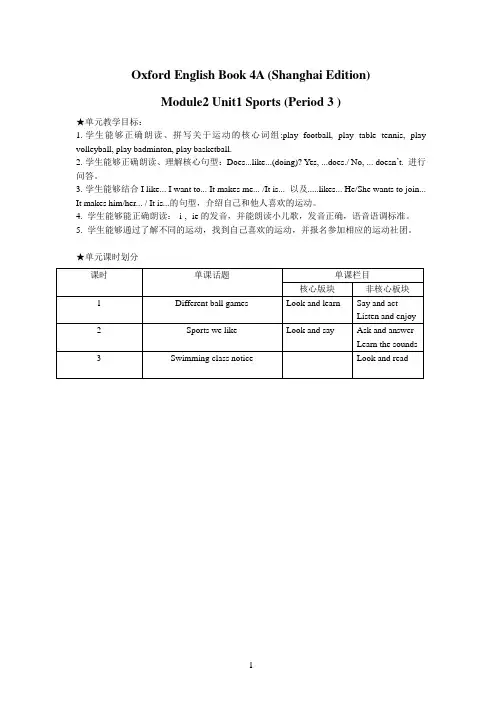
Oxford English Book 4A (Shanghai Edition)Module2 Unit1 Sports (Period 3 )★单元教学目标:1.学生能够正确朗读、拼写关于运动的核心词组:play football, play table tennis, play volleyball, play badminton, play basketball.2.学生能够正确朗读、理解核心句型:Does...like...(doing)? Yes, ...does./ No, ... doesn’t. 进行问答。
3.学生能够结合I like... I want to... It makes me... /It is... 以及.....likes... He/She wants to join... It makes him/her... / It is...的句型,介绍自己和他人喜欢的运动。
4. 学生能够能正确朗读:-i-, -ie的发音,并能朗读小儿歌,发音正确,语音语调标准。
5. 学生能够通过了解不同的运动,找到自己喜欢的运动,并报名参加相应的运动社团。
★单元课时划分★单课教学目标单课教学目标、文本及教学过程4B Module2 Unit1 SportsSwimming class notice (Period 3)教学目标:1.学生能够在语境中朗读并尝试说出有关于游泳所需物品的词汇 a pair of swimming goggles, a swimsuit, a swimming cap, a towel, a pair of slippers, 发音标准。
2.学生能够借助板书,朗读、并运用句型For a swimming class, I need...I should remember to...尝试说出游泳课需要的物品和游泳课注意事项,发音标准,语音语调正确。
3.学生能够通过解读游泳课注意事项,知道如何为游泳课做好准备,激发学生热爱游泳运动的情感。
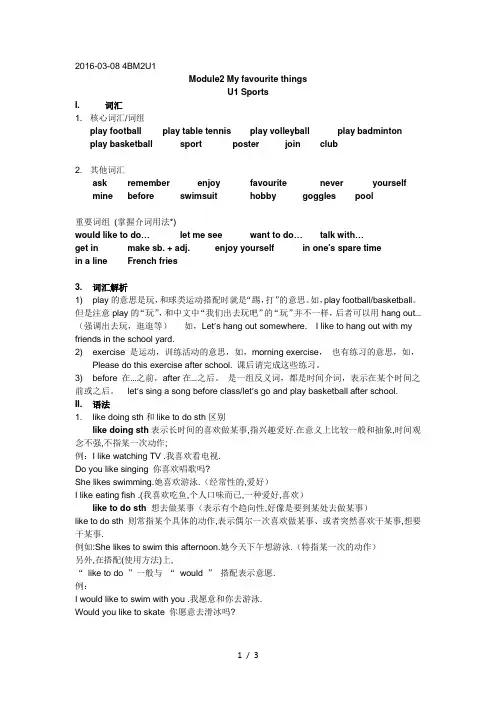
2016-03-08 4BM2U1Module2 My favourite thingsU1 SportsI. 词汇1. 核心词汇/词组play football play table tennis play volleyball play badminton play basketball sport poster join club2. 其他词汇ask remember enjoy favourite never yourself mine before swimsuit hobby goggles pool重要词组(掌握介词用法*)would like to do…let me see want to do…talk with…get in make sb. + adj. enjoy yourself in one’s spare timein a line French fries3. 词汇解析1) play的意思是玩,和球类运动搭配时就是“踢,打”的意思。
如,play football/basketball。
但是注意play的“玩”,和中文中“我们出去玩吧”的“玩”并不一样,后者可以用hang out…(强调出去玩,逛逛等)如,Let’s hang out somewhere. I like to hang out with my friends in the school yard.2) exercise 是运动,训练活动的意思,如,morning exercise,也有练习的意思,如,Please do this exercise after school. 课后请完成这些练习。
3) before 在…之前,after在…之后。
是一组反义词,都是时间介词,表示在某个时间之前或之后。
let’s sing a song before class/let’s go and play basketball after school.II. 语法1. like doing sth和like to do sth区别like doing sth表示长时间的喜欢做某事,指兴趣爱好.在意义上比较一般和抽象,时间观念不强,不指某一次动作;例:I like watching TV .我喜欢看电视.Do you like singing 你喜欢唱歌吗?She likes swimming.她喜欢游泳.(经常性的,爱好)I like eating fish .(我喜欢吃鱼,个人口味而已,一种爱好,喜欢)like to do sth想去做某事(表示有个趋向性,好像是要到某处去做某事)like to do sth 则常指某个具体的动作,表示偶尔一次喜欢做某事、或者突然喜欢干某事,想要干某事.例如:She likes to swim this afternoon.她今天下午想游泳.(特指某一次的动作)另外,在搭配(使用方法)上,“like to do ”一般与“would ”搭配表示意愿.例:I would like to swim with you .我愿意和你去游泳.Would you like to skate 你愿意去滑冰吗?2. 重点句式一般疑问句Does…?在一般陈述句中,当句子的主语是单数第三人称时,谓语动词要加-s或-es。
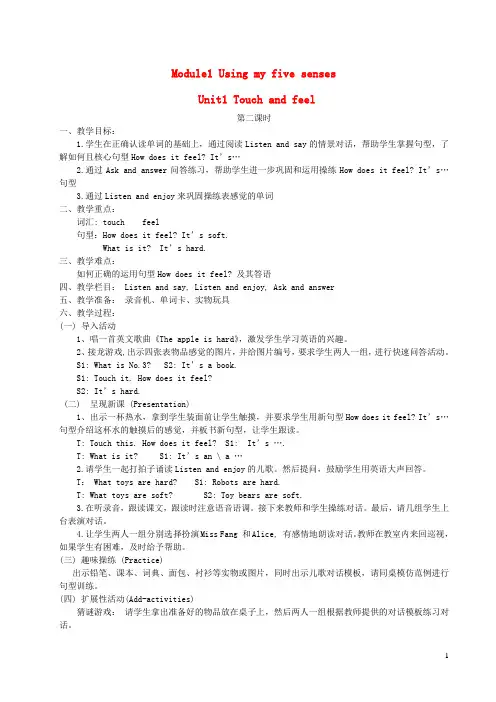
Module1 Using my five sensesUnit1 Touch and feel第二课时一、教学目标:1.学生在正确认读单词的基础上,通过阅读Listen and say的情景对话,帮助学生掌握句型,了解如何且核心句型How does it feel? It’s…2.通过Ask and answer问答练习,帮助学生进一步巩固和运用操练How does it feel? It’s…句型3.通过Listen and enjoy来巩固操练表感觉的单词二、教学重点:词汇: touch feel句型:How does it feel? It’s soft.What is it? It’s hard.三、教学难点:如何正确的运用句型How does it feel? 及其答语四、教学栏目: Listen and say, Listen and enjoy, Ask and answer五、教学准备:录音机、单词卡、实物玩具六、教学过程:(一) 导入活动1、唱一首英文歌曲《The apple is hard》,激发学生学习英语的兴趣。
2、接龙游戏,出示四张表物品感觉的图片,并给图片编号,要求学生两人一组,进行快速问答活动。
S1: What is No.3? S2: It’s a book.S1: Touch it. How does it feel?S2: It’s hard.(二) 呈现新课 (Presentation)1、出示一杯热水,拿到学生装面前让学生触摸,并要求学生用新句型How does it feel? It’s…句型介绍这杯水的触摸后的感觉,并板书新句型,让学生跟读。
T: Touch this. How does it feel? S1: It’s ….T: What is it? S1: It’s an \ a …2.请学生一起打拍子诵读Listen and enjoy的儿歌。

Period 1一、主要新授内容(new contents)Ask and answer---How many children in Class 4A have dogs? Three children have dogs.Do a survey--- Have you got a pet? Yes, I’ve got a ___.What color is it? It’s … What’s its name? Its name’s…二、学习目标(Objectives)1、通过对宠物的调查和描述让学生熟练Wh-question和Have got句型的一般疑问句的操练。
并用这些句型来获取有效信息。
2、学会看图表,锻炼统计概括能力。
三、教学建议1、任务前期准备阶段(Pre-task preparation section)Pre-task Preparation是指我们要求学生运用目的语(即所学的语言)之前,呈现给学生的新语言材料。
也就是我们常说的:Input。
在这个环节主要让学生获得对新语言材料的第一次感知。
Activity 1 (Chant)1、教学辅助(Aids)1) 电脑2)屏幕3) 剑桥儿歌磁带 Do you have a pet?Activity 2 Song1、教学辅助(Aids)1) 电脑2)屏幕2.活动过程(Process)2、任务中期实施阶段(While-task procedure section)While-task Procedure,这是指语言技能的习得过程。
其中分为机械性操练和意义性操练两部分。
机械性操练可以让学生准确地模仿、复说新授的语言,让他们经过从模仿到识记的过程,使新知识由感知、理解、模仿直到储存。
通过不同形式的教学活动,保持学生的学习兴趣。
Activity 1 Pass it on1、教学辅助(Aids)1) 电脑2)录音机Activity 2 (Pair work)1、教学辅助(Aids)图片录音机完成比较扎实的机械性操练,就进入了意义性操练阶段。
Unit 1 Look!Teaching Con tents: P2-P5Teaching Aims:1.Lear ners develop their range of stati on ary vocabulary2.Learners collect objects and talk about what belongs to whom3.Learners in groups play a miming game to guess what others are doing4.Learners act as a boss or a secretary in a role-play and talk about what the staff membersare doing in the office5.Learners prepare a slide show and write about where people are in school and what peopleare doingTeaching Focus:ing predictive adjectives to describe objects and nouns to identify object2.Asking z wh z questions to find out specific information about a personing dem on stratives to refer to objects4.Asking z wh z questions too find out which person sth belongs toe.g. Whose pens are these?ing the present continuous tense to describe an action taking place at thetime of speaking.e.g. What are you doing? Km drawing・6.Asking z wh z questions to find out the place・e.g. Where are Peter and Betty?ing the present continuous tense to describe an action taking place at thetime of speaking.e.g. What's he doing?Teaching Time: 4 periods1st lessonTeaching Contents:P2Teaching Aims:Learners develop their range of stationary vocabularyLanguage focus:ing predictive adjectives to describe objects and nouns to identify object2.Ask "wh7 questions: z What have you got?'Teaching Type: NewMaterials:Cassette, cassette player word and picture cardsProcedures:1.Pre-task preparation Warming up: Review the sounds.Have students works in pairs and list out the things in their school key ona sheet of paper. Invite students to tell the class what they have got・ You may introduce newvocabulary or you may take this to encourage pair learning.2.While-task procedures:1)Words: What do you need for a class?Paint 颜料brush 刷了felt pens 水彩笔thin 薄thick 厚Look at the book, which one is thick・ Which one is thin?2)Say and act. At the bookshopa.Look. These crayons are thin. Those crayons are thin.b.Which felt pens are new? Which ones are old? new-old 新■旧c.Show the brush to the pupils. Ask which one is long, which one is short.These brushes are long. Those brushes are short.d.What have you got? I've got these crayons. They're thick.3.Post-task activities1)Listen to the cassette and read after it.2)Look at the objects and say sth about it.e.g. These crayons are new.Those ____________ old.What have you got?I've got ___________ •They are _____________ .Blackboard designbrush ( es) new-oldpaint thin-thickfelt pens these-thoselong-short4.Assignment:1)Oral: Recite the words and sentences.2)Written work: Copy it.Summarize:这一课主要教学几个有关文具的名词和修饰他们的形容词,大部分学生掌握较好,极个别学生paint发咅不准确,稍加纠正就没问题了,只是在作业中发现these, those作为形容词性指示代词使用的英语习惯掌握不扎实,需加强练习。
Unit 1 Look!Language skills:Listening:Identify key words in an utteranee by recognizing the stressLocate specific information in response to simple questionsSpeaking:Open an interaction by eliciting a responseMaintain an interaction by providing information in responseUse appropriate intonation in questions and statementsWriting:Develop written texts by adding personal ideas and information to writing Develop written texts by putting words in a logical order to male meaningful phrases or sentencesDifficult points:Prepositions: Behind, beside, in, on, under4Wh J question: Where\What\Whose...?Materials: Pictures, recorder, tapesTeaching Times:Five periodsThe First PeriodTeaching tasks:Word:: brush do felt-pen paint sleep talk think Grammar: these thoseWhat have you got? I have got...Whose...are these? Where's…?Difficult and main points:These... Those・・・Teaching breach: Using the things, compare and try to say.ProcedureContents MethodPurposePre-task preparation 1. Song2. Daily talk3. RevisionPs sing togetherT-PP-PWhile-task procedure Look and learnThick/ thinThese / thosepaint brush feltpenWhat have yougot?1 .T. show the pictures andlearn the words・ Paint/ felt pen/paint Make phrases.Brush—brushes Paint—paintsFelt pen—felt pens2. Compare two books.Show: thin—thick Learn theword.4. Try to say:5. E.G. The rubber is thick. Theruler is thin.6. show the things and show:these/those7. Compare the opposite. Tryto say: These — are —. Those— are —.8. T: What have you got? I'vegot these —.T-PP-tP-P通过用事物来引出学习文具,在学习使用中掌握单词.在对事物的比较中引出单词,在对比和使用中学会他的不同含义并灵活运用.Post-task activities Workbook pagel P・P ask and answerListen to the tape and repeat.Read in role.HomeworkCopy the wordsand sentencesListen and read.寓学于乐让学生轻松、快乐、高效地学习地是我们的追求的游戏,是我们的好帮手之一。
(沪教牛津版)四年级英语下册教案Module 1 Using my five sensesUnit 1 Look!Teaching Contents: P2—P5Teaching Aims:1. Learners develop their range of stationary vocabulary2. Learners collect objects and talk about what belongs to whom3. Learners in groups play a miming game to guess what others are doing4. Learners act as a boss or a secretary in a role-play and talk about what the staff members are doing in the office5. Learners prepare a slide show and write about where people are in school and what people are doingTeaching Focus:Using predictive adjectives to describe objects and nouns to identify objectAsking ‘wh’ questions to find out specific information about a personUsing demonstratives to refer to objectsAsking ‘wh’ questions too find out whi ch person sth belongs toE.g. whose pens are these?Using the present continuous tense to describe an action at the time of speaking.E.g. what are you doing? I’m drawing.Asking ‘wh’ questions to find out the place.E.g. where are Peter and Betty?Using the present continuous tense to describe an action taking place at the time of speaking.E.g. what’s he doing?Teaching Time: 4 periods4th lessonTeaching Contents:P5Teaching Aims:Learners prepare a slide show and write about where people are in school and what people are doingLanguage focus:Asking ‘wh’ questions to find out the place. E.g. where are Peter and Betty?Using the present continuous tense to describe an action taking place at the time of speaking.E.g. what’s he doing?Teaching Type: NewMaterials:Cassette. Cassette player.Procedure:ⅠWarming upHave a dictationAnswer the question.Whose chair is this? (我的)Whose ruler is that? (Peter的)Whose bags are these? (我们的)Whose books are these? (她的)What are you doing? (读书)What are the children doing? (跳舞)What’s Danny doing? (写字)What’s Miss Tang doing? (说话)Are you cooking? (是的)Are you jumping? (不在教室里)ⅡWhile-task procedure:Look at the pictures and answer the questions:Where’s Danny? He is in the playground.What’s he doing? He is playing.Where’s kitty? She is in the hall.What’s she doing? She is saying.Where are Peter and Betty?They are in the library.What are they doing? They are reading.要多练习进行时的一般疑问句ⅢPost-task Activity1. Listen to the cassette and practise it in two.2. Ask and Answer (P5)First oral then write.Blackboard designWhere’s ……? /Where are….?He’s/She’s /It’s/They’re…….Assignment1. Oral: Recite “Look and Say.2. Written: Copy it.教学效果反馈:1.教学目标基本达到,但是现在进行时要多操练和讲解。
Unit1 My petPeriod 2一、主要新授内容(new contents)Read the poem---mop,Play game--- Using imperatives to give instructionsUsing predicative and attributive adjectives to describe animals二、学习目标(Objectives)1. 通过诗歌的朗读学习音律的有关知识。
2.学会按照指示完成一个任务或指导别人按指示完成任务。
3.学会用合适的形容词描述物体。
4.用一段话有条理的描述物体。
5.根据二期课改新课标的要求,在确保完成基本教学目标的基础上,可以结合学生的学习能力和语言的实际使用对教材呈现的教学内容进行拓展,本课中可以让学生试着写写小诗,在写文章时补充一些形容词:cute, lovely, strong等,补充句型:It likes to do sth. I like it because…等三、教学建议1、任务前期准备阶段(Pre-task preparation section)Activity 1 (Poem)1、教学辅助(Aids)1) 电脑2)屏幕3)磁带Activity 2 Guessing game 1、教学辅助(Aids) 1) 电脑 2)屏幕Activity 3 (Memory game) 1、教学辅助(Aids) 1) 电脑 2)屏幕 3)图片2、任务中期实施阶段(While-task procedure section)Activity 1 (repeat ion )1、教学辅助(Aids)图片录音机Activity 2 Pair work1、教学辅助(Aids)1) 电脑2)录音机Activity 3 (pass it on)1、教学辅助(Aids)图片录音机3、任务后期完成阶段(Post-task activity section)Activity 1(Making a riddle )1.教学辅助(Aids)活页资料P13Activity 2(Poem writing )1.教学辅助(Aids)活页资料P18。
Unit1 My petPeriod 4一、主要新授内容(new contents)Look and read--- Words: shakeStory3aPresent continuous tenseLearn the sound--- -sh二、学习目标(Objectives)1. 培养准确的语音语调和流利朗读能力。
2.能在听完故事后,抓住key words对所听内容进行概括整理,归纳人物性格,总结主题,揭示故事的寓意。
3.学习sh的发音4.锻炼学生开放型思维和想象力,锻炼语言组织能力和英语运用能力。
三、教学建议由于这几个故事均有相同点,可以互相借鉴,第三个故事的教学可以仿造前两个故事。
1. 任务前期准备阶段(Pre-task preparation section)Activity 1 (Roll play )1、教学辅助(Aids)Tape recorder2.活动过程(Process)Activity 2(Question and answer )1.教学辅助(Aids)Pictures of Story 1a and 2 a2、任务中期实施阶段(While-task procedure section)Activity 1 (Describe the animals )1、教学辅助(Aids)图片录音机Activity 2 (Learn the word)1、教学辅助(Aids)图片录音机在听故事和跟读时要求学生尽量模仿其语音语调准确;在文章的空格处填入合适的词,使文章完整;(老师可以去掉一些关键字如动词,主语等)最后再读读填完的文章。
3、任务后期完成阶段(Post-task activity section)Activity 1(Roll play )1、教学辅助(Aids)头饰等表演用具2.活动过程(Process)可事先做好头饰,学生分组表演,允许学生适当丰富故事内容。
Activity 2(Write a new story )1.教学辅助(Aids)练习纸。
Module2 My favourite things
U1 Sports
I.词汇
1.核心词汇/词组
play football play table tennis play volleyball play
badminton
play basketball sport poster join club
2.其他词汇
ask remember enjoy favourite never yourself
mine before swimsuit hobby goggles pool
重要词组 (掌握介词用法*)
would like to do…let me see want to do…talk with…
get in make sb. + adj. enjoy yourself in one’s spare time
in a line French fries
3. 词汇解析
1) play的意思是玩,和球类运动搭配时就是“踢,打”的意思。
如,play
football/basketball。
但是注意play的“玩”,和中文中“我们出去玩吧”的“玩”并不一样,后者可以用hang out…(强调出去玩,逛逛等)如,Let’s hang out somewhere. I like to hang out with my friends in the school yard.
2) exercise 是运动,训练活动的意思,如,morning exercise,也有练习的意思,如,
Please do this exercise after school. 课后请完成这些练习。
3) before 在…之前,after在…之后。
是一组反义词,都是时间介词,表示在某个时间之前或之后。
let’s sing a song before class/let’s go and play basketball after school.
II. 语法
1. like doing sth和like to do sth区别
like doing sth表示长时间的喜欢做某事,指兴趣爱好.在意义上比较一般和抽象,时间观念不强,不指某一次动作;
例:I like watching TV .我喜欢看电视.
Do you like singing 你喜欢唱歌吗
She likes swimming.她喜欢游泳.(经常性的,爱好)
I like eating fish .(我喜欢吃鱼,个人口味而已,一种爱好,喜欢)
like to do sth想去做某事(表示有个趋向性,好像是要到某处去做某事)
like to do sth 则常指某个具体的动作,表示偶尔一次喜欢做某事、或者突然喜欢干某事,想要干某事.
例如:She likes to swim this afternoon.她今天下午想游泳.(特指某一次的动作)
另外,在搭配(使用方法)上,
“ like to do ”一般与“ would ”搭配表示意愿.
例:
I would like to swim with you .我愿意和你去游泳.
Would you like to skate 你愿意去滑冰吗
2. 重点句式
一般疑问句Does…
在一般陈述句中,当句子的主语是单数第三人称时,谓语动词要加-s或-es。
如,She walks alone on the path. 这样的句子变成一般疑问句时,助动词用does,并要注意句中的谓语动词要变回原形。
如, Does she walk alone on the path
练习:1)Lucy goes to school at 8 o’clock every morning.
2) Peter plays with Danny at home.
3) Nancy likes reading story books.
一般疑问句的回答:Yes, 主语+do(es)./No, 主语+do(es)n’t.
II. 语法
1. 一般现在时表示经常发生的动作或经常存在的状态、日常行为或习惯或客观事实,不只特定的时间。
一般现在时通常用动词原形来表示,但当句中的主语为第三人单数时,如he,she,it等时,句子中的谓语动词的词尾要发生变化(在词尾加-s或-es,其变化规则与名词复数变化规则大致相似):
The sun behind the mountain.(rise)
He to the park on Sunday.(go)
They the best paints in the world.(paint)
The children and away.(cry,run)
Mrs. Wang always students math.(teach) *
2. would like 意为喜欢,愿意。
后面接to do,表示喜欢,愿意做某事。
一般疑问句形式Would you like to … 常用来表示客气地邀请某人做某事。
例句:(转换练习)
I would like to have a cup of tea.
Would you like to go to the park with me
I would 可缩写为I’d. I’d love to.常用来回答Would you like to… 表示赞成对方的提议或邀请。
would 其实是will的过去式(表示过去发生的动作),虽然常用来表示将来时间。
当would 不作为will的过去式来使用时,这两个词意思相同,通常可以互换。
只是would比will 语气婉转。
如:Will Kitty come to Would you like to come with me
3. Let me see. She often plays badminton with me. Let’s go and ask her.
Would you like to come with us It makes you healthy and strong.
our是形容词性物主代词,ours是名词性物主代词.都是我们的意思.
our sth=ours 例:they are our toys = the toys are ours.
补充:
动词变现在分词
一.直接在动词后面加-ing
1. do-doing 做
2. stand-standing 站
3. sleep-sleeping 睡觉
4. eat-eating 吃
5. sing-singing 唱
6. drink-drinking 喝
7. read-reading 读8. look-looking 看9. walk-walking 散步
10. watch-watching 看11. draw-drawing 画12. fly-flying 飞
13. open-opening 打开14. jump-jumping 跳15. do-doing 做
16. paint-painting 绘画17. pick-picking 捡18. play-playing 玩
19. garden-gardening 做园艺工作20. talk-talking 说话21. cook-cooking 烹饪22. see-seeing 看见
23. learn-earning 学习24. catch-catching 抓住
25. climb-climbing 爬26. count-counting 数数
27. clean-cleaning 打扫28. fish-fishing 钓鱼
二.动词变现在分词:
以不发音的e 结尾的去e 加-ing
1. come –coming 来
2. dance - dancing 跳舞
3. close - closing 关
4. make –making 制造
5. ride –riding 骑
6. write - writing 写
7. take - taking 拿走8. phone - phoning 打电话跳舞
9. move –moving 移动搬10. have –having 有
三.动词变现在分词:
重读闭音节,双写最后一个辅音字母,再加-ing
1. sit- sitting 做
2. hop - hopping 单脚跳
3. swim- swimming 游泳
4. run - running 跑
5. cut –cutting 切
6. put–putting 放7.get-getting 得到购物跳绳开始
四.以ie结尾的动词,变ie为y,再加ing;。